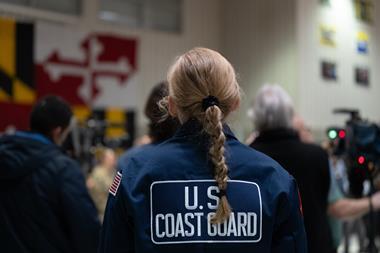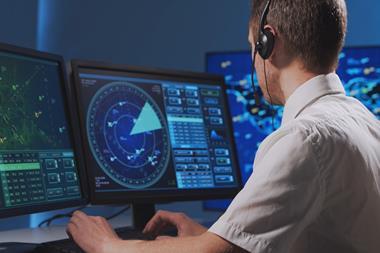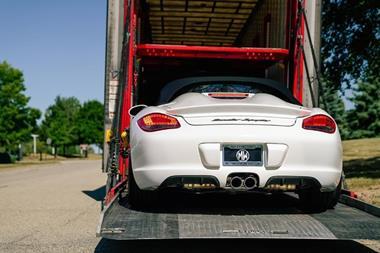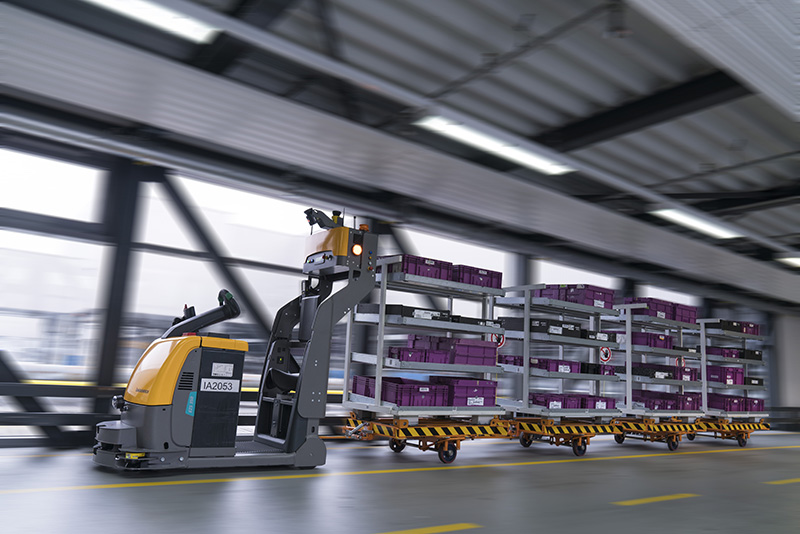 [in_this_story align="right" border="yes"] Advances in automated technology and robotics have already transformed many aspects of automotive manufacturing, with the sector taking a lead in plant technology and automation investment, from stamping equipment to precision welding robots. In the context of increasing digitalisation, manufacturers are looking to go much further, from integrating artificial intelligence to virtual reality and the vigorous application of data.
[in_this_story align="right" border="yes"] Advances in automated technology and robotics have already transformed many aspects of automotive manufacturing, with the sector taking a lead in plant technology and automation investment, from stamping equipment to precision welding robots. In the context of increasing digitalisation, manufacturers are looking to go much further, from integrating artificial intelligence to virtual reality and the vigorous application of data.
In logistics, meanwhile, the rise of the robot has arguably been much less prominent in automotive than in other sectors, notably among e-commerce companies. The ‘fulfilment centre’ warehouses at the likes of Amazon, for example, are increasingly filled with robots and lifting and sorting systems designed to speed the movement, handling and inventory management of products. In the UK, for example, online grocer Ocado has been developing highly advanced automated racking systems to improve inventory picking, supported by intense data collection across its supply chain.
While the automotive sector has incorporated aspects of parts handling automation at plants or large service parts warehouses – notably technologies such as automated storage and retrieval systems (ASRS), in-line conveyors and some truck-loading equipment – the variety of part numbers in cars has made it more difficult to automate handling operations, such as those related to sequencing and kitting. Until recently, the equipment perhaps most associated with logistics automation has been relatively simple automated guided vehicles (AGVs) that move containers or racks of materials along dedicated routes in plants or from storage locations.
However, technology advancements are changing the way staff and robots handle material in plants and warehouses. For AGVs, mobility is no longer confined to navigating magnetic strips or rails in the floor. Plus, like vehicles themselves that are internet-connected, these AGVs are equipped with technology that makes them more than a means to move things from one point to another; improvements in sensor-based technology, image processing and machine vision mean that AGVs and other mobile robots can increasingly carry out more handling of containers and parts.
The scale at which such robots enter automotive production and logistics remains to be seen – however, logistics executives are increasingly talking about ‘human-machine cooperation’ as the supply chain is increasingly digitised.
"The advantage [of ‘naturally’ navigating tugger trains] is that all of this takes place without building the elaborate infrastructure required by other driverless transport systems – for example, in the form of induction loops, floor markings or reflector panels." - Hanns Huber, BMW
[sta_anchor id="1"]With that, the relatively humble AGV is poised to play a leading role. According to recent market research by analyst report firm MarketsandMarkets, the global AGV market will expand by more than 10% per year between 2014 and 2022 to reach $2.81 billion, with the automotive industry “dominating” the market with use of the equipment in plants and warehouses.
BMW’s self-driven driversBMW is among the manufacturers seeking to take a lead in such areas. Over the past year, the company has deployed a range of innovative robotic devices at a number of its German plants, including a small fleet of smart transport robots (STRs) developed together with the Fraunhofer Institute at its international parts packaging plant in Wackersdorf, as well as autonomous tugger trains introduced as part of a pilot project at its Dingolfing plant.
According to Hanns Huber, a spokesman for BMW’s communications production network, the company views itself as an ‘innovation leader’ in production technology, and it has singled out logistics, including inbound, outbound and in-plant, as the area with the greatest potential for innovation for digitalisation and ‘industry 4.0’.
The STRs introduced at the Wackersdorf site are used to autonomously transport containers of parts from handling to logistics areas. Huber explains that each unit navigates its way around the facility using the combination of a digital map and distance measurements generated by wireless transmitters, determining its own position with “centimetre accuracy”. Moreover, he claims, the battery-powered wireless transmitters mounted on walls around the plant can also be cheaply and flexibly extended for use in other areas of logistics “without any major outlay”.

Elsewhere, Huber reveals that a pair of autonomous tugger trains BMW is piloting at the Dingolfing plant have already helped to increase efficiency, especially where longer distances are involved between individual warehouses and assembly areas. “For example, the trains can be used to bring vehicle parts from an automated small parts warehouse to the sequencing centre in the right order for assembly,” Huber says.
While the automation of parts movement within a plant is not unique to BMW, the autonomous driving and sensor-based technology within these robots represents potentially important developments for BMW. The independent steering and navigation function of each train is enabled with what Huber describes as a ‘laser multilateration’ or ‘natural’ navigation system, which essentially means that location and navigation are handled via an onboard computer that receives and evaluates laser signals transmitted from an opto-electronic sensor mounted on the top of each unit. In doing so, the trains generate a digital, two-dimensional room profile in real time, enabling them to manoeuvre through the assembly hall and logistics areas along certain routes.
“The advantage is that all of this takes place without building the elaborate infrastructure required by other driverless transport systems – for example, in the form of induction loops, floor markings or reflector panels,” he says. “Both pilots [have been] well received and have delivered valuable results for further steps in these innovation projects.”
BMW is also interested in using more flexible automation equipment and robots. One prototype, for example, uses a 3D camera to trace objects and obtain information about what it needs to pick up, allowing it to perform tasks that have traditionally been more difficult to automate, such as parts picking. In a pilot in Leipzig, the robot is currently used to assist workers with picking and transporting empty containers.
Such automation is part of a move away from what BMW’s senior logistics and production management describes as the central-steering of logistics through IT and planning, to ‘self-steering’ in which transport and replenishment are guided by the internet-connected objects in the supply chains themselves.
[related_topics align="right" border="yes"]BMW has plans to roll out the tugger trains and STRs at other plants in Germany and elsewhere over the next few years, but while the OEM’s logistics leadership wants to set the pace in logistics automation and innovation, such investments are carefully targeted and calibrated according to business case. There will be no automation just for automation’s sake.
[sta_anchor id="2"]“Logistics needs to support the growth of the BMW Group through flexibility, on-time delivery and managing complexity. We are only implementing logistics topics that really make sense and will improve our logistics and production system,” adds Huber.
Bringing vision to handlingMore self-guided AGVs at automotive plants are also in evidence across the Atlantic. For example, Pennsylvania-based materials handling equipment supplier Seegrid has supplied the manufacturing industry across the US with vision-guided vehicles (VGVs) for more than a decade. According to vice-president of products and services Jeff Christensen, the Seegrid VGV – itself the result of decades of research by Dr Hans Moravec, a world-renowned robotics expert at Carnegie Mellon University – takes standard industrial equipment and kits it out with proprietary machine vision technology.
“With five pairs of stereo cameras on each vehicle and the ten cameras working in sets of two, like human eyes, our VGVs ‘see’ their environment with precision,” says Christensen. “Our proprietary vision technology serves as the brains of the vehicle and our algorithms help the robot understand and remember its surroundings so that it can navigate complex environments autonomously.”
Seegrid already counts companies like Jaguar Land Rover, Volvo, Daimler, Aisin, BMW and a large American carmaker among its VGV customers.
For Seegrid’s VGVs, as with BMW’s STRs, the key advantage of using such autonomous devices is that they don’t require a dedicated infrastructure for their guidance system to function, whether wires installed in the floor, magnets or tape affixed to the floor surface, or mirrors attached to walls to reflect lasers.
“These older technologies are incredibly inflexible and require large-scale structural overhauls any time the manufacturer wants to adjust the vehicle’s route,” adds Christensen. “On the other hand, our devices are 100% infrastructure-free. When a robot is deployed in a facility, it only needs to be ‘trained’ one time, and it can then [sta_anchor id="3"]run that route autonomously for as long as needed.”
Seegrid equipment is also equipped with a fleet management system, Seegrid Supervisor, which allows plant managers to collect and share data with existing systems in their plants.
Shuttling between technologiesAnother approach is the Take Away Shuttle concept, currently under development by Austrian robotics outfit Knapp, which is based on a combination of two of the company’s existing technologies. The first is a warehouse rack-picking device, known as an YLOG-Shuttle, which combines crosswise and lengthwise movements with a rotation function to reach a wide variety of rack positions in a given level. Specially designed lifts are also used to transport the YLOG unit between different rack levels – making a single shuttle capable of serving an entire rack system.
“The freedom of movement that the YLOG-Shuttle provides makes new types of rack systems possible. Differing ceiling heights, square floor spaces, angled rooms or multiple floors can now be automated,” says Christian Brauneis, director of the industry business unit at Knapp Industry Solutions.
The Take Away concept includes the use of open shuttles – free-moving robots used to transport material in warehouses or assembly lines, as well as to supply workstations. These robots are also able to manoeuvre without optical or physical aids and, like Seegrid vehicles, connect to a fleet management system to optimise transport routes, coordinate vehicles and guide the manoeuvring activities. Combining these technologies offers new possibilities, especially around the physical handling of parts and containers.
“The basic idea of the Take Away concept was to use the same handling unit technology on both shuttles. So the handling unit of the YLOG-Shuttle was installed on the Open Shuttle. This enables the interaction between both systems and means the Open Shuttle Take Away is able to place containers at static drop points,” says Brauneis.
Although Knapp has already notched up a great deal of development, testing and experience on both systems, Brauneis stresses that the key innovation is the new handling unit on the Open Shuttle, as well as the combination of both systems.
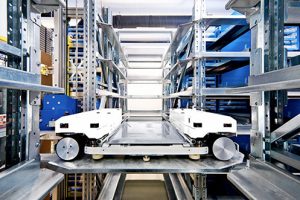 Knapp’s Take Away Shuttle concept combines the capabilities of its YLOG- and Open Shuttles to provide a highly flexible transport solution
Knapp’s Take Away Shuttle concept combines the capabilities of its YLOG- and Open Shuttles to provide a highly flexible transport solution“With the use of the Take Away concept in both the storage and the navigation system, all places and positions in the warehouse could be reached easily. This would enable a high degree of freedom and high flexibility. The key challenge is to get used to the free navigation technology in warehouses,” he says.
“Every car is an individual item, which causes a high dynamic in sequencing. Due to these circumstances, shuttles – both rack-based and free-navigating – are the most flexible solution,” he adds.
Looking ahead, Brauneis predicts that the automation and digitalisation of assembly line sequencing will emerge as key trends. He also confirms that Knapp has well-established plans for the future rollout of the Take Away system with OEMs' plants around the world.
One of these is the Volkswagen Group, which selected Knapp as top innovator in the area of logistics innovations during its the 11th Logistics Innovation Day late last year in Wolfsburg. According to a press statement at the time, the Knapp Open Shuttle Take Away stood above 128 other competitors – and 18 other finalists – after a process that involved several stages including concept presentations, hearings and factory visits.
Seegrid’s Jeff Christensen believes that as automotive manufacturing grows further in the US, including some ‘near shoring’ of products from far-flung regions, increasing automation will play a crucial role, with the expected increases in efficiency allowing US manufacturers to create better products at a lower cost and redeploy skilled workers in more valuable jobs.
Christensen expects a continuing confluence in technology development between Silicon Valley investment and more traditional manufacturing centres in the US, like Detroit-based carmakers, but also other robotic firms in the country, including its own base in the north-east.
“Silicon Valley is pouring resources into the automated car race, and we know with that region’s power of innovation that automation technology will be key to creating the next wave of driverless cars.
"And we couldn’t leave out our hometown, Pittsburgh,” adds Christensen. “Between the city’s recent partnership with Uber’s autonomous vehicles and our own CMU robotics roots, our region represents the east coast robotics movement well.
“As automakers continue to invest in robotics, and as humans continue to adapt to working alongside machines, we anticipate an increase in human-robot collaboration in the auto industry in the decades to come,” he concludes.
"With five pairs of stereo cameras on each vehicle and the ten cameras working in sets of two, like human eyes, our vision guided vehicles ‘see’ their environment with precision [and] can navigate complex environments autonomously." - Jeff Christensen, Seegrid



















